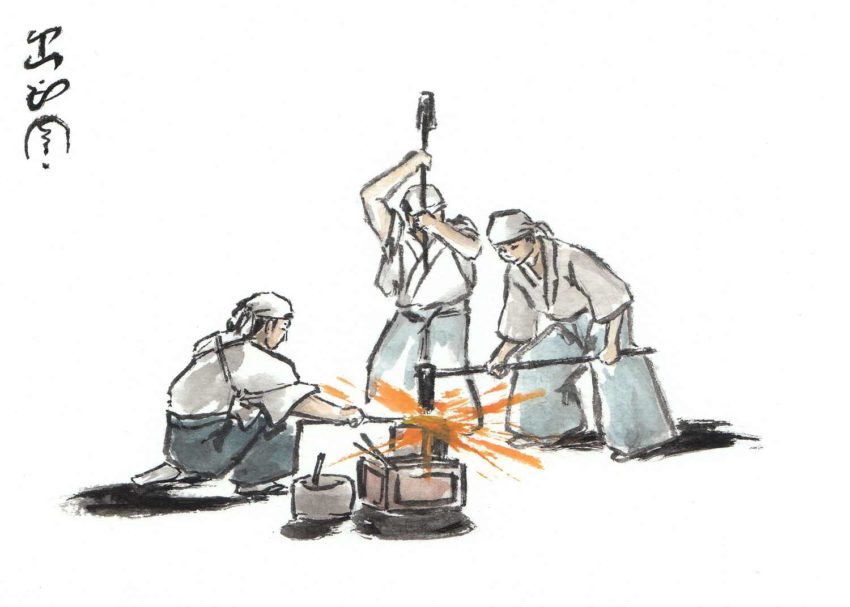Few weapons span the bridge between ancient history and modern pop culture like the hand forged Japanese katana. With confidence and deadly grace, these weapons continue to fascinate. Over the course of months, these swords are built by master swordsmiths. The utmost versatility and balance are of utmost importance. From the ancient battlefields of Edo Japan to the modern collector’s case, hand-forged Japanese katanas are bold, stunning, and uniquely memorable. Some modern martial arts, like kendoKENDO 剣道 "the way of the sword" learn more... and ninjutsuNINJUTSU 忍術 "the skill of prowling" learn more..., still utilize the katana in their practices to this day.
Creating a hand forged Japanese katana is no easy feat. Each sword is painstakingly crafted by master swordsmiths using techniques perfected over the course of centuries. Often, a team of swordsmiths will work together on a single blade, each smith specializing in a specific step of the process, like forging or polishing. The culmination is a perfectly balanced sword as beautiful as it is lethal.
What is a Katana?
A katana is a type of sword that was historically used by samurai warriors in feudal Japan. While ancient European swords were designed for either stabbing or slashing, katanas were engineered to do both. For that reason, they’re uniquely versatile among bladed weapons.
Built to be slim and lightweight, a katana measures between 23 and 28 inches long on average and weighs between 2 and 3 pounds. The weapon’s signature curved blade allows it to “glide” over a target in addition to being sharp enough to slice through a piece of silk as it falls through the air.
How to Make a Hand Forged Japanese Katana
At this point, you may be wondering how such a fine weapon is crafted. Here are the steps a katana goes through during production, from the raw steel to the polished blade on proud display:
Tamahagane: Creating the Raw Steel
The term tamahaganeTAMAHAGANE 玉鋼 "jewel steel" learn more... (meaning “jewel steel”) is an extremely pure form of steel used to create katanas. Tamahagane is made by heating a mixture of iron sand and charcoal to high temperatures in a specially-built clay oven called a tataraTATARA 踏鞴 "iron-smelting furnace" learn more.... Heating the sand mixture into workable steel usually takes three days and three nights.
Shita-kitae: Forging
Raw tamahagane is filled with impurities that would weaken the finished blade. To remove these impurities, the metal is stacked, heated up, and hammered repeatedly. This stage, shitakitaeSHITAKITAE 下鍛え "hammering in forging" learn more..., is physically strenuous and is usually done by several people.
Orikaeshi tanren: Folding the Forged Steel
Next, additional impurities need to be removed from the steel. This step, orikaeshi tanrenORIKAESHI TANREN 折り返し鍛錬 "folding step in forging" learn more..., involves folding and refolding the heated metal many, many times. During this process, the metal is cooled down with water and re-heated to a moldable consistency. The repetition of heating and cooling causes the steel’s surface to oxidize.
Hizukuri: Hammering the Blade Into Shape
Once the impurities have been taken out of the steel, the purified metal is beaten into the shape of a blade. The swordsmith uses hammers of various sizes and, in a process known as hizukuriHIZUKURI 火造り "hammering into shape" learn more..., a chisel to shape and sand down the outline of the blade.
Tsuchioki: Treating the New Blade with Clay
The process of cooling down the metal of a hand forged Japanese katana is just as important as the initial heating stage. An improperly cooled blade will not have the proper strength, flexibility, and curvature. In order to begin the cooling process, the blade must be subjected to tsuchiokiTSUCHIOKI 土置き "putting dirt on" learn more... – that is, covered in clay. Rather than using raw clay, the swordsmith creates a paste by mixing water with the clay, although every swordsmith uses his own personal recipe which may also include ash, rust, or pulverized stone. The clay coating is allowed to harden around the blade.
Yakiire: Quenching the Blade
The yakiireYAKIIRE 焼き入れ "quenching [in fire]" learn more... stage imbues the katana with its distinctive, curved shape.
First, the clay-coated sword is re-heated to 1400ºF in a hearth. Next, the heated blade is pulled from the hearth and plunged into a box of water to rapidly cool it down, causing the metal to contract and warp into the subtle curve that katanas are known for. Not all blades survive this step. If a blade has any lingering impurities or structural weaknesses, it will crack when it enters the water. As many as one in three katanas are destroyed this way.
In addition to creating the blade’s distinctive curve, the yakiire quenching process is also responsible for another of the katana’s trademark features: the hamonHAMON 刃文 "blade pattern" learn more.... The hamon is the distinctive horizontal line that runs down the entirety of the blade, from hilt to tip. This line is formed by the clay which prevents that section of the blade from being tempered.
Togi: Polishing the Blade
For this step, the blade is typically handed off to a smith who specializes in polishing. The entire polishing process can take up to two months before completion.
Fine-grained sanding stones are worked against the blade’s surface until it takes on a mirror-like quality. Oftentimes, the hamon is polished until it becomes matte, creating a distinctive contrast against the gleaming shine of the rest of the blade. TogiTOGI 研ぎ "sharpening/polishing" learn more... is what gives a katana its famous sheen.
The Finishing Touches
Once the hand forged Japanese katana has been shaped and polished to a diamond-sharp gleam, it needs to be affixed to a hilt and outfitted with a scabbard.
Hilt (Tsuka)
Katana hilts, called tsukaTSUKA 柄 "handle or hilt" learn more..., are made of a lightweight piece of wood for ease of handling. Designed for two-handed wielding, the hilt is relatively long and closed off with either a circular or square guard depending on the style. If you look closely at a katana’s hilt, you’ll notice that it has a cross-hatched pattern wrapping from front to back. This design is called a “battle wrap” and it’s made by wrapping ray skin (samegawaSAMEGAWA 鮫皮 "shark skin" learn more...) around the wooden hilt and weaving it together with strips of silk, cotton, or leather.
The combination of ray skin and braided fabric makes the sword less likely to slip out of the wielder’s hands. Some katanas have additional ornamentation on the hilt, like carved metal in the shape of a warrior or a lotus blossom, for additional traction against the bearer’s palm.
Handguard (Tsuba)
To protect the wielder’s hands during combat, a handguard (tsubaTSUBA 鍔 "sword's hand guard" learn more...) constructed of an iron disk is affixed to the spot where the hilt meets the blade. Katana handguards range from plain and functional to elaborately decorated with ornaments like dragons or cranes. Historically, ornate handguards were typically favored by members of the nobility.
Scabbard (Saya)
Katana scabbards are traditionally made from lacquered wood, although some higher-end sayaSAYA 鞘 "scabbard/sheath" learn more... also include water buffalo horn. Scabbards can be relatively plain and unadorned or wrapped with a knot of silk to add an extra design element. Traditionally, a scabbard was used to safely transport and store a katana when it’s not in use. Be careful removing the katana from its scabbard – the ferociously sharp blade is unforgiving to any fingers that get in its way!
Sword Stands
Most hand forged Japanese katana are displayed on a sword stand to showcase their beauty and craftsmanship. While there’s no right or wrong way to display a katana, they’re typically housed on a single or double sword stand. In the past, samurai warriors carried a katana along with a smaller sword called a wakizashiWAKIZASHI 脇差 or 脇指 "medium-length sword" learn more.... On a double sword stand, the katana always rests on the top rung with the wakizashi on the rung beneath it.
Katanas are also usually displayed with the hilt pointed to the left and the arch of the blade facing upward to fully display the variegated hamon, which looks like a smoky shadow on the blade’s underbelly. Japanese swords can be presented on a stand either with or without the scabbard. But be warned – an unsheathed katana traditionally symbolizes war!
Complete Your Collection with a Hand-Forged Japanese Katana
Whether it’s displayed among other swords and armor, perched in a collection of historical artifacts, or used by practitioners of Japanese sword fighting and martial arts, a finely crafted, hand-forged katana is sure to steal the show. And now that you know about each step involved in hand-crafting a katana, you can impress your friends with your newfound knowledge, too!
Just like the tamahagane jewel steel it’s crafted from, a katana would easily become the crown jewel of your collection.

